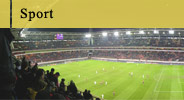The RDS in Dublin turned yellow, green and red on the weekend of 9-10 March as the Lithuanian community organised the fifth Festival of European Cultures in the capital.
The annual spring fair celebrates Lithuanian heritage, but other European cultures were also promoted, with several concerts and dances from Russia, Bulgaria and Ireland among the festivities.
Typical foods and crafts from Bulgaria and Czech Republic were also showcased.
Lithuanian ambassador to Ireland Vidmantas Purlys told Metro Éireann that the spring fair “is a traditional event in Lithuania that started during the 17th century in Vilnius, the Lithuanian capital.”
The Kaziukas fair, as it is known in Lithuania, is organised every year at the beginning of spring and enables local craftspeople to market their products. The tradition first “spread to [neighbouring] countries and it is now also expanding abroad in places where there is a sizeable Lithuanian community,” said Ambassador Purlys.
Hundreds attended the event at the RDS where they were able to learn Lithuanian folk dances, and taste and buy ruginÄ— duona (rye bread), dry sausages, honey cookies, sweets, local honey and gira, a soft drink made of rye bread and flavoured with fruit.
“I haven’t been in Lithuania for many years… and you can’t get this food on a daily basis in Ireland,” said Edita, who came to the festival to meet other Lithuanian people and buy traditional food to feel closer to home.
Craftspeople from Vilnius and other parts of Lithuania also came to the RDS to showcase their products such as knitted clothes, wooden bird calls, handmade soap and ‘palm’ bouquets, which are made of colourful dried flowers and typically brought to church on Palm Sunday.
A smithy was set up at the entrance where a blacksmith forged souvenirs for curious visitors.
The event was mainly attended by Ireland’s sizeable Lithuanian community, and a lot of families were there to make sure that the younger generation do not forget their cultural heritage.
Virgius, a Lithuanian father of two, said he tries to maintain this heritage at home. “It is very important to have my daughters immersed in our culture. At home we try to speak Lithuanian only and when they go to school they speak English – we try to keep both languages at the same level.”
Irish people interested in foreign cultures were also present. Briana O’Doherty came to the event “to try something different,” she said. “I love learning about different cultures and languages.”
The Lithuanian community is the third largest immigrant group in Ireland, with 36,683 people recorded in the 2011 Census, after the Polish and British communities with 122,585 and 112,259 members respectively.











